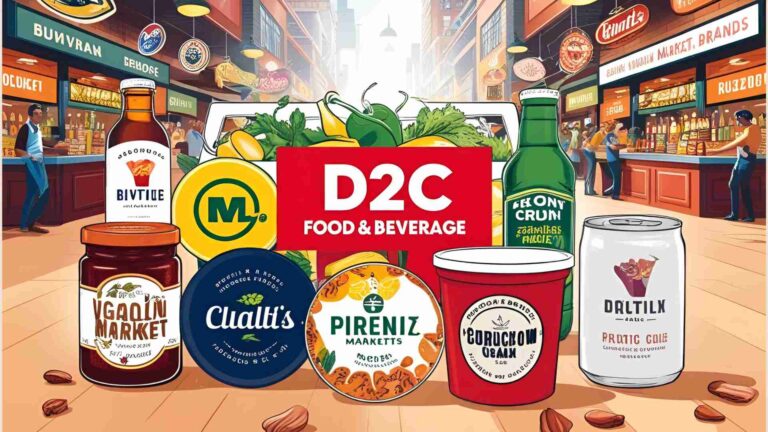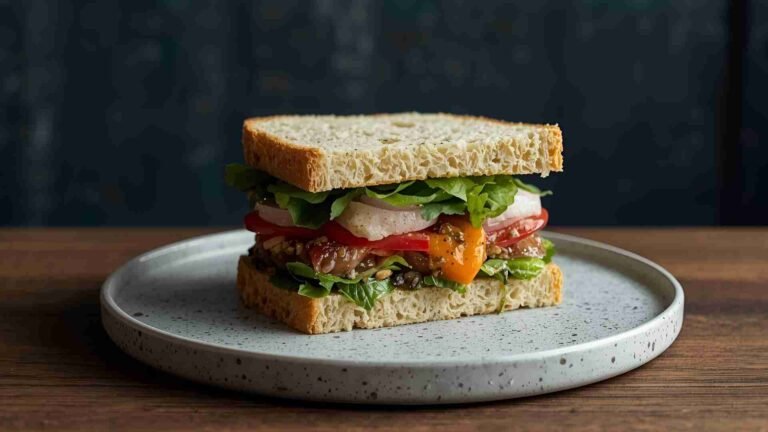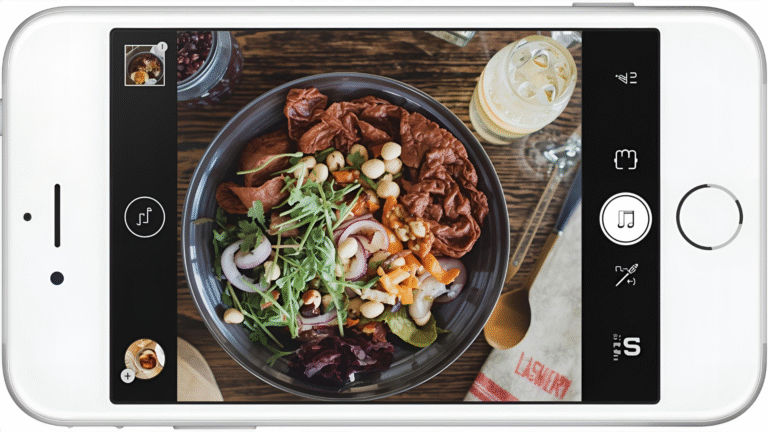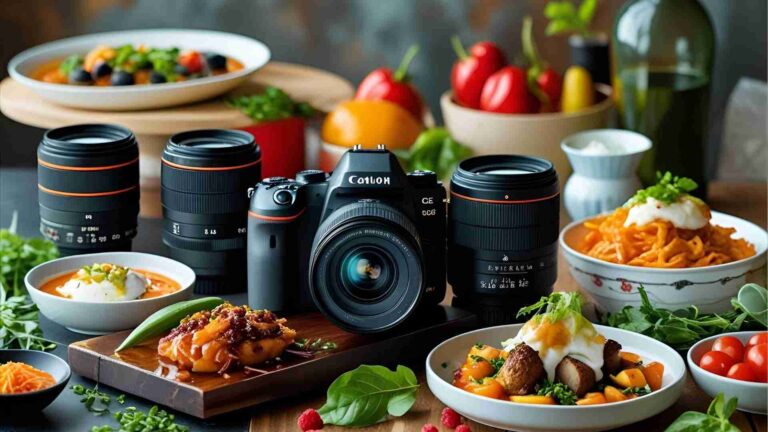How to Correctly Attribute a Recipe
Learn how to correctly attribute a recipe with our comprehensive guide. Understand copyright laws, ethical practices, and SEO benefits for food bloggers.
In the vibrant world of food blogging and recipe development, sharing culinary creations is a cornerstone of community engagement. However, with the ease of republishing recipes online through a quick copy-and-paste, ethical and legal questions arise about proper attribution. Whether you’re a seasoned food blogger, a cookbook author, or an enthusiastic home cook sharing recipes online, understanding how to correctly attribute a recipe is crucial. This guide delves into the nuances of recipe attribution, exploring copyright laws, ethical considerations, SEO benefits, and practical steps to ensure you respect the original creators while enhancing your content. We’ll also provide actionable examples, charts, and best practices to make your recipes both legally sound and engaging for your audience.
Understanding Recipe Copyright Law
Recipes occupy a unique space in intellectual property law. According to the U.S. Copyright Office, a mere list of ingredients – such as those found in recipes, formulas, or prescriptions- is not subject to copyright protection. However, when a recipe includes substantial literary expression, such as detailed explanations, instructions, or creative narratives, it may qualify for copyright protection. This distinction is critical for food bloggers and publishers.
For example, a simple ingredient list like “flour, sugar, eggs, butter” cannot be copyrighted. However, a recipe with a detailed narrative about the cultural history of a dish, specific cooking techniques, or a personal story accompanying the instructions may be protected. Similarly, a collection of recipes, such as those in a cookbook, may also be copyrighted as a whole.
In the UK and Europe, the issue of recipe copyright is further complicated by the ethos of culinary experimentation. Andrew Charlesworth, a legal expert, notes that cookery relies heavily on borrowing, tweaking, and fusing existing recipes, which makes it challenging to establish originality for copyright purposes. Most recipes evolve from prior works, meaning that while some may be wholly original, many are adaptations of existing dishes.
Key Takeaways from Copyright Law
- Ingredients Lists: Not copyrightable.
- Instructions and Narratives: Potentially copyrightable if they contain substantial literary expression.
- Collections: Cookbooks or recipe compilations may be protected as a collective work.
- Originality: Recipes that are significant departures from existing ones may qualify for protection, but common recipes (e.g., chocolate chip cookies) often do not.
To navigate this gray area, food bloggers must focus on ethical attribution rather than relying solely on legal boundaries. Proper attribution not only ensures compliance with copyright law but also fosters respect within the culinary community.
The Ethics of Recipe Attribution
Beyond legal considerations, recipe attribution is a matter of ethics and professional courtesy. Copying a recipe word-for-word without permission and passing it off as your own is plagiarism, a serious offense in publishing. Even unintentional copying can undermine the hard work of the original creator, who may have spent hours testing, refining, and writing the recipe.
The golden rule applies: treat others’ work as you would want yours treated. If you expect credit for your original recipes, extend the same courtesy to others. This principle is especially relevant in the digital age, where platforms like Pinterest and Facebook make it easy to share recipes without proper citation. For instance, reposting a recipe directly from another blog without linking back to the source disregards the creator’s effort and can harm their visibility.
Why Attribution Matters
- Respect for Creators: Acknowledging the original source honors the time, creativity, and expertise invested in developing the recipe.
- Community Building: Proper attribution fosters trust and collaboration within the food blogging community.
- SEO Benefits: Linking to reputable sources can improve your blog’s search engine rankings by demonstrating relevance and authority.
- Engaging Content: Sharing the story of how you discovered or adapted a recipe adds depth to your blog posts, making them more engaging for readers.
When and How to Attribute a Recipe
Determining when to attribute a recipe depends on how closely your version resembles the original and the extent of changes you’ve made. Below, we outline scenarios and best practices for attribution, along with examples to guide you.
Scenarios for Recipe Attribution
| Scenario | Description | Attribution Required? | How to Attribute |
|---|---|---|---|
| No Changes to Ingredients or Instructions | You replicate the recipe exactly, including the ingredient list and instructions. | Yes, attribution is required. Instructions may be copyrighted. | List the ingredients and provide a direct link to the original source for instructions. Include a note like, “Recipe courtesy of [Source Name].” |
| Same Ingredients, Different Instructions | You use the same ingredients but rewrite the instructions in your own words. | Yes, attribution is recommended. | Include a link to the original source with a note like, “Adapted from [Source Name].” |
| Substantial Changes (3+ Ingredients and Instructions) | You significantly alter the ingredients (e.g., change at least three) and rewrite the instructions. | Optional, but recommended for transparency. | Note that the recipe was “Inspired by [Source Name]” with a link to the source. |
| Common Recipes | The recipe is a classic (e.g., grilled cheese sandwich, vinaigrette) with no unique elements. | No attribution required. | No action needed, as these recipes are considered common knowledge. |
| Unique Variations | The recipe includes distinctive elements (e.g., homemade cheese, unique spice blends). | Yes, attribution is required. | Link to the original source and mention the unique elements, e.g., “Inspired by [Source Name]’s unique chipotle grilled cheese.” |
Practical Examples of Attribution
Example 1: Minimal Changes
Lillian, a food blogger, finds a recipe for pasta with butternut squash, spinach, hazelnuts, and Parmesan cheese in a cookbook. She swaps butternut squash for acorn squash, spinach for kale, and hazelnuts for walnuts, then writes the instructions in her own words. To attribute properly, she includes the following in her blog post:
“This delicious pasta dish was inspired by [Cookbook Name] by [Author Name]. Find the original recipe here or grab the book [here](purchase link).”
She also adds a similar note in the recipe card for clarity.
Example 2: Significant Changes
Suppose you find a recipe for Crock Pot Pumpkin Risotto with ingredients like butter, olive oil, sage, onion, garlic, verjus, vegetable stock, white wine, arborio rice, roasted pumpkin puree, salt, pepper, nutmeg, and Parmesan cheese. You adapt it by omitting olive oil, replacing sage with tarragon, adding mushrooms, using carnaroli rice, and swapping verjus for mushroom-infused vinegar. Since the recipe is now significantly different, attribution is optional. However, you might include:
“This mushroom-tarragon risotto was inspired by a pumpkin risotto I saw on Anyonita Nibbles.”
Example 3: Common Recipe
For a basic grilled cheese sandwich using cheddar and American cheese, cooked with butter in a frying pan, no attribution is needed. This recipe is considered common knowledge, as many people use similar ingredients and methods.
Best Practices for Attribution
- Link to the Original Source: Always provide a working link to the original recipe, preferably on the author’s website or the publisher’s site.
- Use Clear Language: Terms like “Adapted from,” “Inspired by,” or “Courtesy of” clarify the relationship between your recipe and the original.
- Include Purchase Links: For cookbook recipes, link to where the book can be purchased as a courtesy.
- Get Permission for Verbatim Republication: If you want to republish a recipe word-for-word, seek written permission from the creator or publisher.
- Add Context: Share the story of how you discovered the recipe or why you adapted it. This enhances your content and engages readers.
Writing a Reliable Recipe with Proper Attribution
Creating a reliable recipe goes hand-in-hand with proper attribution. A well-written recipe ensures that readers can replicate your dish successfully, while attribution maintains ethical standards. There are two primary approaches to recipe writing: quantifiable and instructional. Each has its strengths, and many recipe developers combine elements of both.
Quantifiable Approach
The quantifiable approach focuses on precise measurements, times, and temperatures, similar to recipes found in conventional cookbooks. This method is ideal for recipes requiring exact proportions, such as baking.
Best Practices
- Measure Accurately: Use a scale to measure ingredients in grams for precision, especially for baking recipes. Record all measurements during testing.
- Test Thoroughly: Prepare the recipe multiple times, noting any adjustments to quantities or cooking times.
- Include Descriptive Cues: Supplement measurements with sensory indicators (e.g., “the dough should be smooth and slightly tacky”).
- Avoid Retroactive Conversions: Never estimate weights (grams) from volume measurements (cups) after cooking. Use a calibrated chart for accurate conversions.
Example: Bechamel Sauce (Quantifiable)
Here’s a sample recipe for bechamel sauce using the quantifiable approach:

Ingredients:
- 30g (2 tbsp) unsalted butter
- 30g (1/4 cup) all-purpose flour
- 500ml (2 cups) whole milk, warmed
- Salt and nutmeg to taste
Instructions:
- Melt butter in a saucepan over medium heat.
- Add flour and stir to form a smooth paste (roux). Cook for 2-3 minutes until it smells nutty.
- Gradually whisk in warm milk, ensuring no lumps form.
- Simmer for 5 minutes, stirring constantly, until the sauce thickens and coats the back of a spoon.
- Season with salt and a pinch of nutmeg.
Notes: If the sauce is too thick, add more milk in small increments. For a cheesier version, stir in 120g (1 cup) grated cheddar.
Instructional Approach
The instructional approach emphasizes sensory cues and techniques, allowing for flexibility in measurements. This method is suitable for dishes where intuition plays a larger role, such as sauces or stews.
Best Practices
- Provide Visual and Sensory Cues: Describe how the dish should look, smell,-exclusive-or feel at each stage.
- Demonstrate Techniques: Include detailed explanations or visuals (e.g., videos or photos) to guide readers.
- Clarify Approximations: If measurements are approximate, note this clearly to avoid confusion.
- Offer Troubleshooting Tips: Include advice on correcting mistakes, such as adjusting ingredient ratios.
Example: Bechamel Sauce (Instructional)
Here’s the same bechamel sauce recipe using the instructional approach:

Ingredients:
- About 2-3 tbsp unsalted butter
- About 2-3 tbsp all-purpose flour
- About 2-3 cups whole milk
- Salt and nutmeg to taste
Instructions:
- Melt butter over medium heat until foamy.
- Stir in enough flour to form a thick, bubbly paste, similar to pancake batter. Cook, stirring, until it smells nutty, about 2-3 minutes.
- Gradually pour in milk while whisking, stopping when the sauce is thick but pourable, not gloopy.
- Simmer, stirring constantly, until the sauce coats a spoon.
- Season with salt and a pinch of nutmeg. If too thick, add more milk; if too thin, simmer longer.
Notes: Adjust flour or milk to achieve the desired consistency. Use warm milk to prevent lumps.
Combining Both Approaches
Most successful recipe writers blend quantifiable and instructional elements. For example, provide precise measurements for critical ingredients while including sensory cues to guide less experienced cooks. This hybrid approach ensures clarity and flexibility.
The SEO Advantage of Attribution
Proper recipe attribution isn’t just ethical – it’s a smart SEO strategy. Linking to high-quality external sources, such as the original recipe or a cookbook’s purchase page, signals to search engines that your content is relevant and authoritative. This can boost your blog’s ranking on Google, driving more traffic to your site.
Additionally, attribution enhances user experience by providing context and resources, which Google rewards. For example, linking to a cookbook’s Amazon page or the author’s website offers readers valuable information, increasing engagement and time spent on your site.
SEO Tips for Recipe Attribution
- Use Relevant Anchor Text: Use descriptive anchor text (e.g., “Original recipe by [Author Name]”) for links.
- Link to High-Authority Sites: Choose reputable sources like established blogs or publishers.
- Incorporate Attribution Naturally: Weave attribution into your narrative to maintain reader engagement.
- Optimize for Keywords: Include keywords like “recipe attribution,” “adapted recipe,” or “inspired by” in your content.
Practical Tips for Recipe Developers
To create reliable, attributable recipes, follow these steps:
- Research Thoroughly: Study similar recipes to understand common techniques and ingredient ratios.
- Test Rigorously: Prepare the recipe multiple times, measuring ingredients precisely and noting adjustments.
- Write Clearly: Use consistent formatting for ingredient lists and instructions. Specify prepped forms (e.g., “2 cups diced carrots”).
- Include Notes: Add tips on substitutions, troubleshooting, and storage in headnotes or footnotes.
- Attribute Properly: Always credit the original source if your recipe is inspired by or adapted from another.
Sample Attribution Workflow
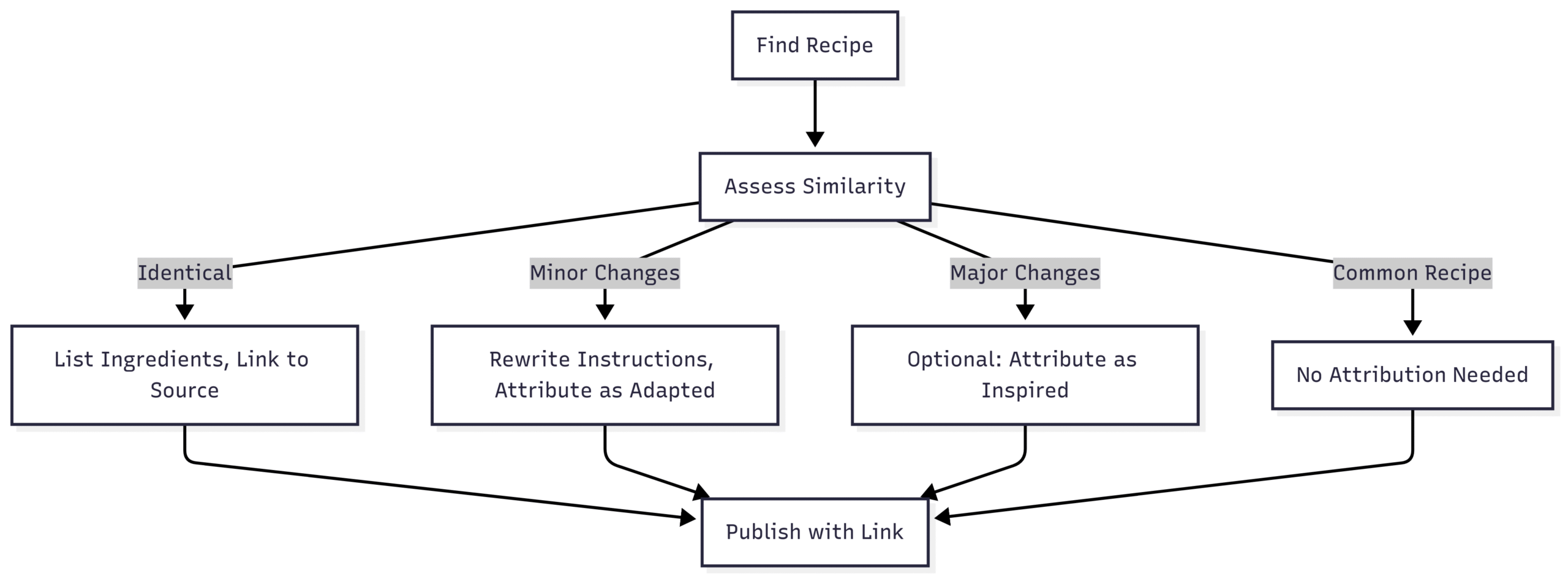
Common Pitfalls to Avoid
- Copying Verbatim: Never republish a recipe word-for-word without permission, even with attribution.
- Vague Attribution: Avoid generic phrases like “found online” without a specific link.
- Inaccurate Measurements: Ensure all measurements are tested and accurate, especially weights.
- Ignoring Permissions: For cookbook recipes, confirm with the publisher which recipes can be shared.
- Overlooking SEO: Failing to link to reputable sources can reduce your content’s authority.
Conclusion
Properly attributing a recipe is a blend of legal compliance, ethical responsibility, and strategic content creation. By understanding copyright laws, following ethical guidelines, and adopting best practices for recipe writing and attribution, food bloggers can create reliable, engaging content that respects the culinary community and boosts SEO performance. Whether you take a quantifiable or instructional approach, the key is to communicate clearly, test thoroughly, and give credit where it’s due. By doing so, you’ll not only avoid legal pitfalls but also build trust with your readers and fellow creators, fostering a vibrant and respectful food blogging community.
Please share these How to Correctly Attribute a Recipe with your friends and do a comment below about your feedback.
We will meet you on next article.
Until you can read, Establishing a Niche as a Food Creator


